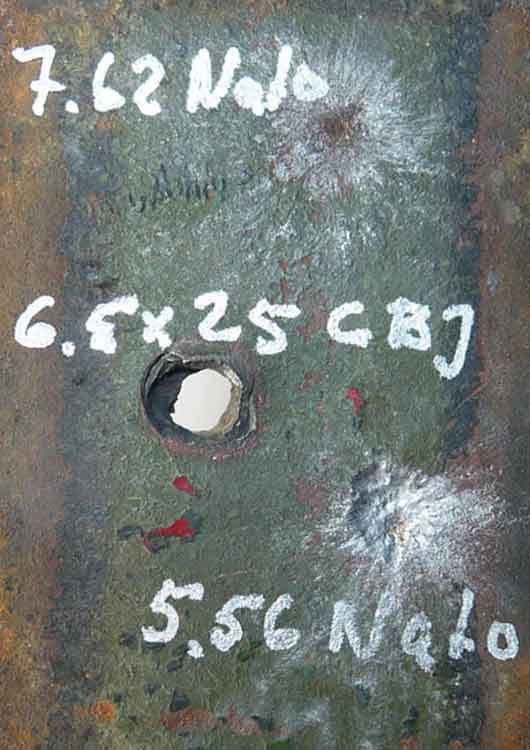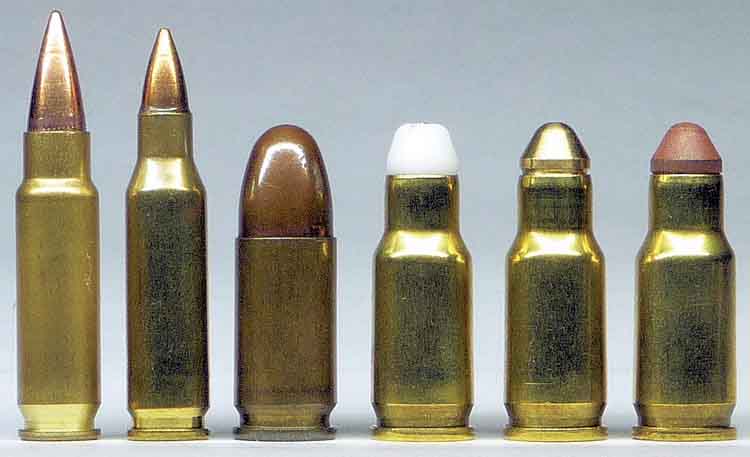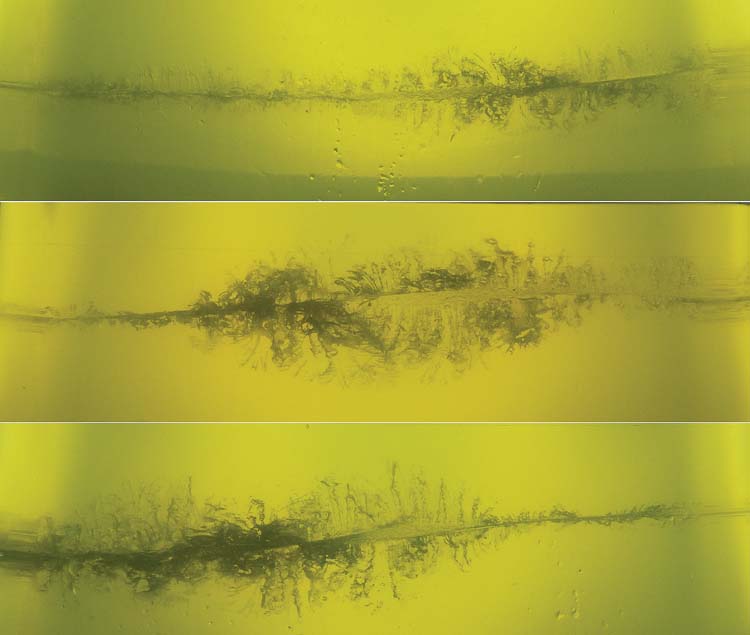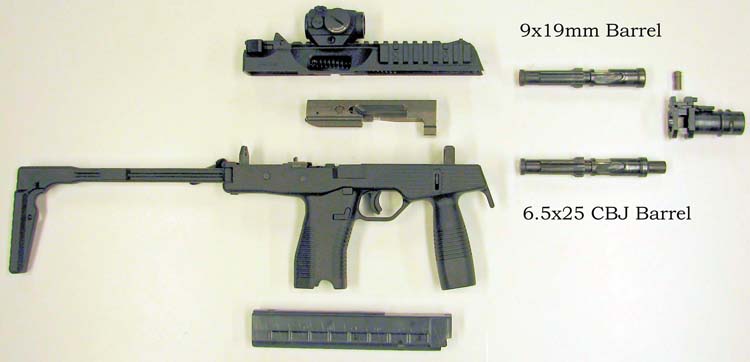The phone call from Carl Bertil Johansson in early summer 2009 came out of the blue. The founder of the Swedish company CBJ Tech had read an article I’d written about military Personal Defence Weapons (PDWs) for soldiers who do not normally carry a rifle. I had concluded that the optimum weapon configuration would be a compact machine pistol like the 9mm Brügger & Thomet MP9. I had also observed that the gun’s ballistics could be transformed by adapting it to fire the 6.5×25 CBJ cartridge. He thought this idea sounded promising so had contacted Brügger & Thomet, who were interested enough to supply him with an MP9 featuring a prototype barrel in 6.5×25 calibre. Initial testing had made him so enthusiastic that he was calling to invite me to Sweden to try the gun and ammunition combination for myself. How could I refuse?
The MP9
The MP9 has been developed from the Steyr Tactical Machine Pistol or TMP, to which Brügger & Thomet acquired the rights in the early 2000s. This innovative Swiss company has made a number of modifications, the most obvious being a side-folding shoulder stock, which transforms the steadiness of aim and the effective range. They have also added a NATO accessory rail on top for optical sights, ghost ring rear sights with an adjustable foresight, a trigger safety (similar to the Glock system), a suppressor attachment on the barrel sleeve (B&T also make the suppressors), and translucent magazines for 15, 20, 25 or 30 rounds. Options include a Picatinny rail under the barrel in lieu of the fixed handgrip, and a fixed skeleton rather than folding stock. The standard colour of the body is black but green and coyote tan are also available, as is a blue version adapted to fire Simunition FX training ammunition (which can also work with the new Force on Force cartridge recently introduced by ATK) and a red “manipulation” gun which cannot fire live ammunition and is used for safe handling training.
The result is an exceptionally compact and lightweight submachine gun or machine pistol, largely made from polymer and weighing just 1.4 kg (3.1 lbs) empty. Loaded 9mm magazines weigh 240 grams (8.5 oz) for 15 rounds to 440 grams (just under 1 lb) for 30 rounds. The MP9 is 303 mm (11.9 inches) long with the stock folded and 523 mm (20.6 inches) with the stock unfolded. Barrel length is 130 mm (5.1 inches). Unlike most SMGs (with the notable exception of the Heckler & Koch MP5 series) the gun fires from a closed and locked bolt, utilising a rotating barrel locking system; it will still fire when the muzzle is pressed against the target. The cyclic rate of fire is 750-800 rpm. The single shot/automatic selector and manual safety switch is a push-button by the thumb.
According to B&T, about 5-6,000 MP9s are sold every year. The gun is widely exported and is now in service with many special forces and close protection teams. The use of the ubiquitous 9mm cartridge is a significant selling point, along with the compact dimensions, the open holster (the gun clips into it) and the availability of the training versions. The modest penetration of 9mm ammunition isn’t felt to be an issue as hardly any of the expected opposition use body armour (this may not, of course, remain the case indefinitely), and around 50m is regarded as an adequate range for its particular role.
The nearest competitor to the MP9 is the Heckler & Koch MP7. The most obvious difference between them is that the MP7 is available only in HK’s unique 4.6×30 calibre, whereas the MP9 fires the 9×19 NATO, aka Parabellum or Luger, which is readily available from many manufacturers in a very wide range of loadings. At least, that was the case until recently, when the first example of the B&T MP9 in the 6.5×25 CBJ version appeared.
The 6.5×25 CBJ
Carl Bertil Johansson is an experienced gun designer who has worked with Aimpoint and SAAB Bofors among others, but set up CBJ Tech to develop his idea for a high-performance cartridge. The company, a family-run business, is based in southern Sweden and owns a Cold War bunker that provides very secure accommodation for workshops and range testing.
CBJ started development of the 6.5×25 cartridge in the late 1990s at the time of the NATO competition to select a new PDW round. This was intended to replace the 9×19 with longer-ranged ammunition able to penetrate NATO’s CRISAT target (equivalent to contemporary Russian body armour) at 150 metres. The only cartridges officially tested were the 5.7×28 FN developed for the P90, and HK’s 4.6×30 for the MP7. It proved impossible to reach political agreement on which to choose, so no decision was made.

FN and HK both started with “clean sheet” ammunition and gun designs, but Carl Bertil decided on a different approach, reasoning that a cartridge that was interchangeable with the universal 9×19 round by means of a simple barrel swap would have a much wider appeal. It would mean that existing guns could be adapted to fire the new cartridge, and also that guns in the new calibre could be easily changed to 9×19 if required; even the magazines remain the same.
This design principle meant that the new CBJ cartridge would have the same overall dimensions as the 9×19 (including the rim diameter) and would need to develop a comparable recoil impulse to ensure reliable gun functioning. The cartridge that emerged from this study was the 6.5×25, with an extended, necked-down case and a short bullet protrusion. Several different loadings in three ballistic groups have been developed.
To compete with the 5.7mm and 4.6mm rounds in meeting the NATO PDW long-range penetration requirement, a sub-calibre loading is used. The standard military “ball” loading is actually a 4mm calibre tungsten bullet in a plastic sabot. The bullet weighs 2 g (31 grains), 2.5 g with its sabot. There is a “spoon-tip” version designed to encourage more rapid bullet upset on impact, and a training variant using cheaper core material. All of these are fired at a muzzle velocity ranging from 730 m/s (2,395 fps) from a 127 mm (5 inch) barrel (the recommended minimum barrel length) to 900 m/s (2,950 fps) from a 305 mm (12 inch) barrel. The tungsten-cored loadings fired from a 12 inch barrel match the trajectory of the 5.56×45 NATO from an M4 Carbine and have much superior penetration to its standard SS109/M855 ammunition, being able to punch through 9mm armour plate. From a 12 inch barrel, velocity at 300 metres is 578 m/s (1,900 fps) at which range it will still penetrate the CRISAT target.

The 6.5mm version of the MP9 has the barrel extended to 150mm (5.9 inches), giving a muzzle velocity of just over 800 m/s (2,620 fps). By comparison, the 5.7×28 P90 and 4.6×30 MP7 both fire as standard 2 gram (31 grain) bullets at about 720 m/s (2,360 fps). A brass-jacketed 6.5mm ball round weighs 7.5 grams (115 grains) compared with 6.2-6.4 grams (96-99 grains) for the 5.7 and 4.6 rounds and around 12-13 grams (185-200 grains) for 9mm. Loaded 15 and 30-round 6.5mm MP9 magazines therefore weigh about 165 and 290 grams (5.8 and 10.2 oz) respectively. Steel and light-alloy cases are being considered by CBJ, but the initial emphasis is on brass.
The other ballistic groups fire full-calibre 6.5mm bullets. One group, primarily intended for police use, fires lightweight 2.5 gram (38.6 grain) bullets at the same velocities as the sub-calibre loadings. These consist of the HET (high energy transfer) brass bullet and a frangible (polymer/metal powder blend) version for use in training or when barrier penetration needs to be minimised. The HET will also penetrate the CRISAT armour target at short range, but these rounds are most effective within 50 metres as the lightweight bullets rapidly lose velocity. The third ballistic group has just one round – subsonic armour piercing – intended for use with a suppressor. It is much heavier than the other bullets at 8 grams (123 grains) and can also penetrate the CRISAT target.

The 6.5×25 cartridge cases were previously made by reforming 9×29 Winchester Magnum brass, but CBJ Tech now has cases specially made for them. These use slightly thicker brass, requiring some adjustment to the propellant loads. The colour of the sabots has not yet been firmed up; originally these were black but this was changed to white to aid recovery from the indoor range’s backstop which has an outer layer of shredded black rubber. For production purposes, different colours may be used to indicate the loading.

SAAB Bofors was initially involved in helping to market the 6.5x25mm while the NATO competition was running, but is no longer involved with the project. CBJ Tech is continuing to develop the ammunition and demonstrate its capability in a wide variety of converted submachine guns and pistols. Those tested to date range from the Steyr AUG SMG to SIG Sauer and Glock pistols. Where necessary, pistols are fitted with barrels extended to 5 inches. A substantial purpose-designed SMG, the CBJ MS, was initially developed to use the new round and features a folding bipod and an optional large-capacity drum magazine in order to act as a light support weapon out to 400m. However, CBJ Tech is now mainly focused on adapting existing 9mm weapons, particularly the MP9 as this is seen as the ideal combination for the PDW role in which there is growing military interest. The remarkable performance of the 6.5mm cartridge, especially in armour penetration, is such that CBJ is intending to offer their conversions only to military and police customers.
How it Works Together: the MP9 in 6.5×25 CBJ
Once in Sweden I had the opportunity to test-fire the MP9 in both 9mm and 6.5mm calibres alongside other weapons for comparison purposes, in two locations; an outdoor range in semiautomatic fire and in CBJ’s indoor range on automatic. Before this, I had only been able to handle the MP9 so I was keen to see how it performed.
In either calibre the MP9 is a pleasure to shoot. I found the spacing between the butt, the pistol grip and the forward handgrip suited me well. The fat, forward-sloping front handgrip greatly aids control and I would certainly not wish to do without it. For semiautomatic fire the little 1.5x Trijicon sight proved ideal and the effective range of the 6.5mm version firing the saboted tungsten ammunition would probably be around 200 metres. In 9mm calibre or for close-range work a 1x holographic red-dot sight (also tried) might be preferred.
Given the MP9’s small size and weight I was surprised by its controllability in automatic fire. As a UK civilian my opportunities for firing automatic weapons are nearly zero but I found no trouble in keeping the rounds on target when firing short bursts; the little gun was much easier to control than an M16 I tried afterwards.
There was very little difference between firing the 9×19 and 6.5×25 versions of the MP9. Subjectively, the 6.5mm version felt as if it had slightly less recoil. My arrival coincided with CBJ’s working up of loads using their new cartridge cases. They hadn’t finalised this process and the 6.5mm version suffered some failures to feed with the new cases (although it performed very well with the older ones) but that was expected to be a temporary glitch.
A key question in my mind was this: OK, the little 4mm tungsten bullet goes through armour like the proverbial hot knife through butter, but how does it perform against unarmoured personnel? This question could only finally be decided in combat, of course, but ballistic gel provides a repeatable substitute for testing purposes. CBJ Tech has the facilities for this, and performed some tests for my benefit. I witnessed three different cartridges being compared at about 5 metres range; the standard 6.5mm saboted ball (this one first had to penetrate a CRISAT target), the full-calibre 6.5mm HET and the 9×19 NATO FMJ. The results are shown in the photograph. The least impressive was the 9mm, while the 6.5mm HET showed far more disruption with rapid bullet upset. The saboted ball also performed significantly better than the 9mm, and according to previous tests I was shown, the spoon-tip version demonstrates even faster upset as one would expect. Interestingly, on one of the test shots of the saboted rounds the sabot was found stuck into the surface of the gel block, which showed that it had followed the bullet down-range quite closely.
To sum up, the Brügger & Thomet MP9 is arguably the best of the new breed of PDWs – or machine pistols or compact SMGs if you prefer. For only about double the size and weight of a pistol (but half the size and weight of an M4 Carbine) it offers perhaps ten times the effective range plus controllable automatic fire. The use of universally-available 9×19 ammunition is proving to be an important benefit, but if more range or penetration is required the gun can easily and reversibly be converted to the impressive and versatile 6.5×25 CBJ. For any military or law enforcement organisations contemplating a weapon in this class, this could be a winning combination.
More information about the 6.5×25 ammunition is presented on the CBJ Tech website at: www.cbjtech.com.
Brügger & Thomet’s website is: www.brugger-thomet.ch/.
Anthony G Williams is an independent ammunition consultant and co-editor of Jane’s Ammunition Handbook. He maintains a website at www.quarry.nildram.co.uk
| This article first appeared in Small Arms Review V14N3 (December 2010) |










